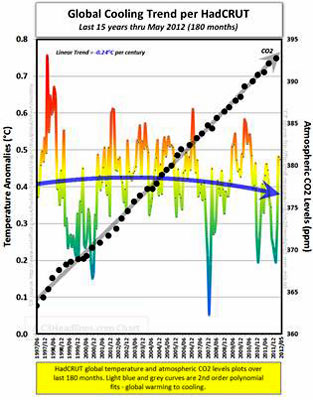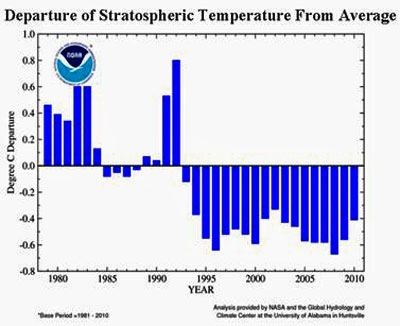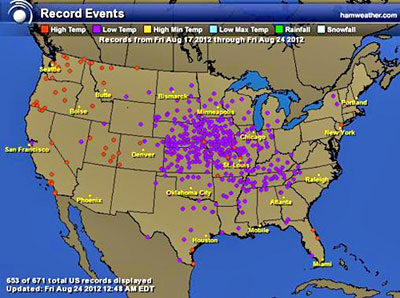|

by Mark Sircus
Director
28 August 2012
from
IMVA Website

Hard to believe anyone these days can talk about global cooling when
it is so darn hot.
So it’s a surprise when we see charts
like this suggesting a slight downward slope to global temperatures.
Don’t get too excited because HadCRUT still insists that we are
up a
degree F in temperature over the last century.
But based on readings from more than
30,000 measuring stations, the data issued by the Met Office and the
University of East Anglia Climatic Research Unit confirms that the
rising trend in world temperatures ended in 1997.
As recently as May Forbes Magazine
wrote,
“Natural climate cycles have already
turned from warming to cooling, global temperatures have already
been declining for more than 10 years, and global temperatures
will continue to decline for another two decades or more.
That is one of the most interesting
conclusions to come out of the seventh International Climate
Change Conference sponsored by the Heartland Institute, held in
Chicago.”
Officially it’s cooling but during the
June 22-28 period, there were 2,132 warm temperature records set or
tied in the U.S., compared to 486 cold temperature records.
This includes 267 monthly warm
temperature records, and 54 all-time warm temperature records. For
the year-to-date, warm temperature records have been outpacing cold
temperature records by about 7-to-1.
But go back to last January and we were
talking another story:
According to the University of
Wisconsin, Madison, on June 11, 2012, the South Pole Station
measured a new record low temperature.
The mercury dropped to
-73.8°C (-100.8°F), breaking the previous minimum temperature
record of -73.3°C (-99.9°F) set in 1966.
There has also been some
serious
cold reported in New Zealand. And in Argentina
serious frosts
have led to a declaration of agricultural emergency and disaster
as citrus crops take a beating.
As we said yesterday in the essay on
heat and drought that even though it’s hot on the ground in the
northern hemisphere its cold as ice up in the stratosphere and
getting colder.
August 2011 was the third coldest on
record in the lower stratosphere, according to the National Climatic
Data Center, and temperatures have been generally declining in
recent years.

As the top chart indicates, over the
last 180 months (15 years) global temperatures have been on a
‘slight’ cooling trend.
This trend persists despite the
increasing levels of atmospheric CO2 and at least two powerful El Niño since 1997. But now we have extreme heat breaking records
right and left.
According to the National Climatic Data Center of the National
Oceanic and Atmospheric Administration (NOAA), the combined
global land and ocean average surface temperature for May 2012 was
0.66°C (1.19°F) above the 20th century average of 14.8°C
(58.6°F).
This is the second warmest May since
records began in 1880, behind only May 2010. The Northern Hemisphere
land and ocean average surface temperature for May 2012 was the
all-time warmest May on record, at 0.85°C (1.53°F) above average.
The globally-averaged land surface
temperature for May 2012 was the all-time warmest May on record, at
1.21°C (2.18°F) above average.

Global monthly
heat content anomaly (GJ/m2)
in the uppermost 700 m of the oceans since January 1979.
The thin line indicates monthly values,
and the thick line represents the simple running 37-month (c.
3-year) average. The increasing ocean temperatures would play havoc
with the air above it. Are underwater volcanoes driving the rise in
ocean temperatures?
People who have known me a few years know that I used to write quite
a bit about global cooling and it is interesting to read that NASA
climate alarmist James Hansen and his colleagues expressed alarm
that the planet was inexplicably cooling three years ago.
In 2009, as the thermometer hit record lows in America, he and other
climate scientists panicked in a flurry of emails:
“Skeptics will be all over us -
the
world is really cooling, the models are no good.”
They lamented that Mother Nature was not
cooperating with their predictions that global temperatures would
smash heat records last decade.
Hansen has taken off his sweater and is again swearing about
man-made warming and the record-breaking heat and drought. Hansen,
often called the “godfather of global warming,” asserted earlier
this month that blistering heat across the United States is so rare
that it can’t be anything but the man-made global warming he has
been warning about for decades.
Does that really explain the dramatic climate events we are seeing
this year? I am sure good ol’Al
Gore will think so but whose intuition (most
sensitive level of feelings as perception) is satisfied these days
by what Gore thinks?
Conclusion
Climatologists are themselves confused about the extreme nature of
the weather, which has made their lives most interesting this past
year.
In terms of science the slight increases
or decreases in temperatures does not seem intense enough to explain
the violent change in climate in many areas of the globe. Looking
around at all the information it seems both colder and warmer thus
the extreme nature of the world’s weather.
What counts and what will hurt most everyone is the fact that
blistering heat in the US has destroyed
45% of the corn and 35% of
the soya bean crop in the worst harvest since 1988. Russia and
Ukraine have also had poor crop yields so the world is going down in
terms of food reserves no matter which way the surface temperature
tracks.
David Archibald
recently delivered to the Institute of World Policy
in Washington DC his analysis of declining sunspot activity, which
to him means that global mean temperatures are going to decline by
about 2 degrees C by 2040 - completely undoing the meager 0.8
degrees C global warming trend we have experienced in the last 150
years.
It is shocking to actually see this
chart from Hamweather.

Leading climate scientists told
The Mail
in January of this year that after emitting unusually high levels of
energy throughout the 20th Century, the sun is now
heading towards a ‘grand minimum’ in its output, threatening cold
summers, bitter winters and a shortening of the season available for
growing food.
When I look at the
information on cooling I am glad that I invested
quite a bit of money this past winter in warm clothing for the
future. At Sanctuary this winter it was cold and even here on the
north east coast of Brazil, in the semi tropics it has been
unusually cool.
I hardly ever have to use the air
conditioner in the winter anymore!
Special Note:
There is probably little to nothing to worry about since the Israeli
and American militaries are planning to start a new war in the
Middle East, which could go thermonuclear - hot enough to warm the
planet despite solar and global cooling.
|




